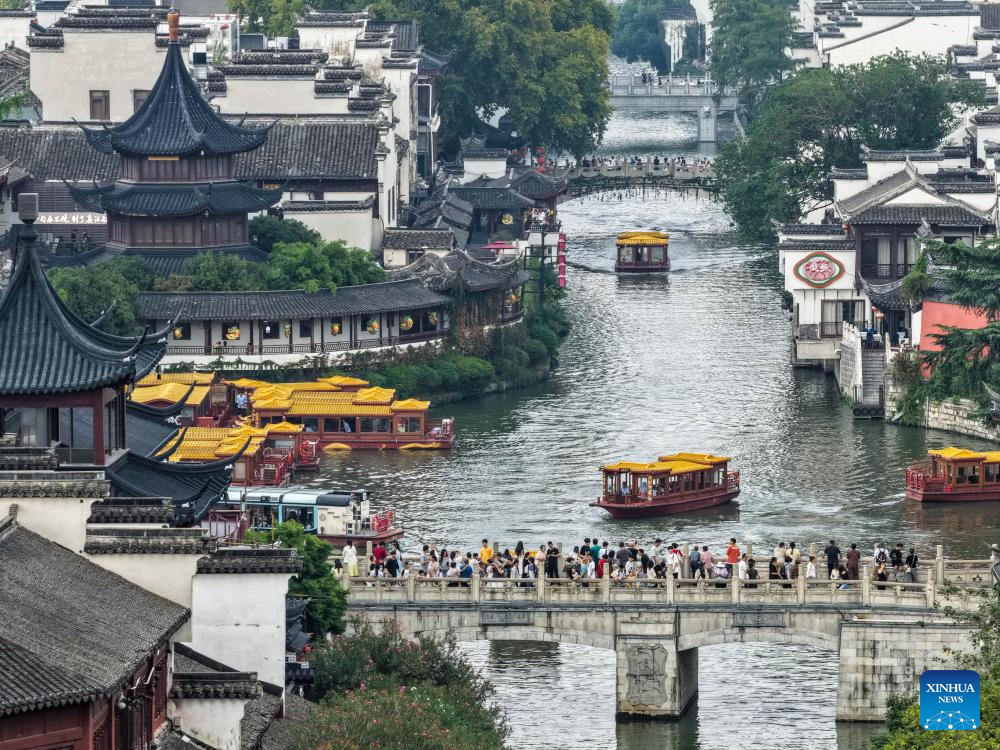


A drone photo taken on Oct. 7, 2025 shows tourists visiting the Fuzi (Confucius) Temple scenic area in Nanjing, east China's Jiangsu Province. (Xinhua/Li Bo)
BEIJING, Oct. 8 (Xinhua) -- Across China, this year's "super golden week" -- the eight-day National Day and Mid-Autumn Festival holiday -- was more than just a break, but a showcase in how to fuel consumer spending through immersive, tailored cultural experiences.
From panda-themed streets in Chengdu to light shows illuminating ancient city walls in Zhengzhou, Chinese cities have implemented distinctive strategies to transform holiday excitement into lasting economic momentum.
In Chengdu, southwest China's Sichuan Province, the giant panda scaling the city's IFS building is more than an art installation -- it's an economic catalyst. During the holiday, panda sculptures, cultural-creative shops, and panda-themed postboxes transformed the city's bustling Kuanzhai Alley into an immersive panda habitat.
Tapping into this internationally recognizable symbol, the Sichuan provincial government launched the fourth China (Sichuan) International Panda Consumption Festival. The event linked scenes across cities like Chengdu, Yibin and Dazhou, backed by 400 million yuan (about 56.3 million U.S. dollars) in consumer vouchers for dining, tea, liquor and tourism. To encourage self-driving travel along National Highway 318, special vouchers for tourists covered vehicle charging, meals and accommodation.
"We aim to turn festive enthusiasm into lasting power through innovative experiences and cross-sector integration," said an official with the Sichuan Provincial Department of Commerce.
Chengdu curated more than 600 events during the festival, from the World Sichuan Cuisine Conference to night markets where the aroma of local delicacies and snacks filled the air. Hotpot restaurants even doubled as cultural stages, with diners watching Sichuan opera face-changing performances while dining.
Sichuan's "comfortable living" lifestyle also emerged as a powerful driver. The province unveiled 40 new consumption scenarios, spanning high-end shopping, cycling on scenic greenways, and leisurely tea sipping in street-side teahouses.
Elsewhere, east China's Fujian tapped into its maritime roots and rich intangible cultural heritage to draw visitors. The province organized 185 heritage-themed events, ranging from exhibitions and folk experiences to craft fairs and hands-on workshops.
In Fujian's Xiamen, the lantern festival held in the city's horticulture expo garden stood out as a centerpiece, blending traditional craftsmanship with modern technology. "We aim to invigorate the night economy while preserving culture and protecting the environment," said Yu Hongping, general manager of Xiamen Cultural Tourism Investment Development Group Co., Ltd.
The garden is open to the public free of charge, featuring lantern displays that intertwine local legends, porcelain artistry, and the city's signature garden landscapes. A bustling bazaar showcasing time-honored brands and local delicacies added to the festive atmosphere, transforming the site into a lively hub of nighttime consumption.
In Fuzhou, capital of Fujian, historical architecture has become a living stage for Fuzhou Pinghua (storytelling in the Fuzhou dialect) and Fuzhou Chiyi (a traditional Chinese narrative singing art originating in Fuzhou) across local cultural blocks. The city's intangible cultural heritage center hosted a vibrant carnival featuring dedicated sessions for Chiyi and Fujian Opera flash mobs. At the same time, visitors tried their hand at the ancient craft of making jasmine concrete.
Similarly, in central China's Henan Province, history was not merely preserved; it was performed. At the newly opened traditional-style modern cultural and commercial block located in the core area of Shang Dynasty (1600 BC-1046 BC) capital city ruins in Zhengzhou, visitors browsed trendy boutiques beside 3,600-year-old Shang Dynasty walls and an Eastern Han Dynasty (25-220) temple. The site drew around 100,000 visitors daily, merging archaeology with commerce through light shows projected onto ancient ramparts and exhibitions on traditional architecture.
"This isn't just a commercial project -- it's an open 'urban living room' where culture and business reinforce each other," said Liu Changhui, the project's operations lead.
Digital innovation added a new layer of dynamism. In Kaifeng's Millennium City Park, visitors lined up for the "Flying over the Riverside Scene at Qingming Festival" dome theater, where IMAX technology brought the Northern Song (960-1127) painting masterpiece to life, requiring no goggles. The visitors were not just viewing the painting -- they were "inside it."
"The cinema was packed during the holiday, with many families bringing their kids to watch the film multiple times," said Xing Xiaoyue from the park's marketing department.
At the Yinxu Museum in Anyang, VR headsets transported visitors into the world of oracle bone inscriptions, letting them experience ancient divination rituals firsthand. Since 2021, Henan has developed 60 smart, immersive tourism spaces that seamlessly blend cultural heritage with cutting-edge technology.
China didn't just welcome tourists, but offered them a role in its cultural story, proving that the best way to spur tourism is to make every visitor feel part of the narrative.
In the country's northeastern and northwestern regions, nature and culture converged to create equally compelling attractions. In Jilin Province, Changbai Mountain's eco-friendly approach showed how sustainable tourism can enhance visitor experiences while safeguarding natural resources. The reserve enforced strict daily visitor caps, refusing to sacrifice environmental integrity for short-term profit.
A smart applet integrated services from tickets to hotels and hot springs, while forest rides and ginseng culture experiences drew visitors like Zhang Han from the neighboring Liaoning Province, who said he planned to spend "tens of thousands of yuan" returning for winter skiing.
Meanwhile, in Xinjiang Uygur Autonomous Region, the ancient city of Kuqa showcased how cultural festivities can power regional tourism. The city staged a series of events that blended cuisine, culture and folk traditions, featuring free tastings of roasted camel and performances in traditional attire. During the first four days of the eight-day holiday, Kuqa welcomed nearly 300,000 visitors, generating tourism revenue of 165 million yuan.
Tourism analysts say China's extended National Day-Mid-Autumn Festival holiday has revealed a clear shift in travel behavior. According to Shen Jiani, a senior researcher with travel platform Trip.com, while the holiday is expected to set a new record for travel volume, the era of superficial "check-in" tourism is fading. It is being replaced by a growing appetite for personalized, in-depth experiences, marking a shift from simple sightseeing to immersive and more profound cultural engagement.
Zhang Xiaoyu, secretary-general of the Xinjiang regional tourism association, attributed this transformation to increasingly rational consumer behavior. He stated that travelers now focus on value for money, distinctiveness, and emotional connection, adding that they are willing to pay for quality experiences that truly deliver on their promise, while turning away from overpriced, cookie-cutter options.
点击右上角![]() 微信好友
微信好友
 朋友圈
朋友圈

请使用浏览器分享功能进行分享
